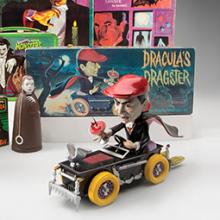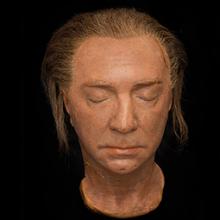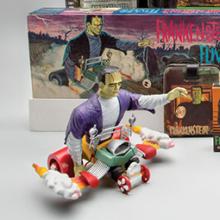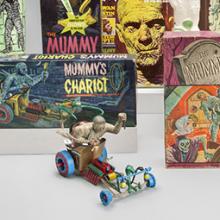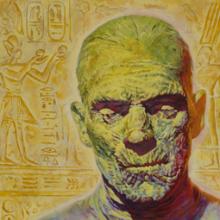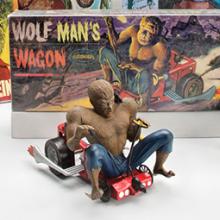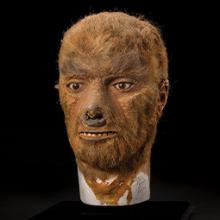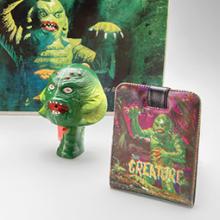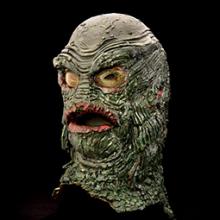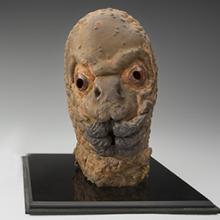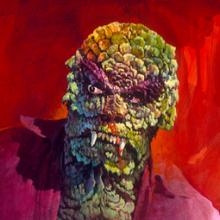Terminal 2












Monster guitars 1992–2008
ESP Custom Shop
Tokyo, Japan
Collection of Kirk Hammett
L2014.3901.079, .080, .081, .082
Dracula toys and memorabilia c. 1960s–70s
various manufacturers
United States and England
Collection of Kirk Hammett
Universal’s Dracula was not the first film based on Bram Stoker’s sensational 1897 novel. The unauthorized German silent film Nosferatu appeared in 1922. Hungarian-born Bela Lugosi (1882–1956), who starred in the 1931 film, gave an unforgettable performance in his most famous role. Although he made nearly seventy more films following Dracula, most people identify the actor as the seductive, but deadly count. He was even buried in Dracula’s black cape.
Dracula begins when English real estate agent Renfield stops in a Transylvanian village en route to Count Dracula’s castle to finalize the paperwork for Dracula’s purchase of an abandoned abbey in an English coastal town. Despite warnings from the villagers not to go, he makes his way to the deadly count’s estate. Renfield is then bitten by Dracula, becomes his servant, and develops an insatiable appetite for flies and spiders. With his newfound assistant, Dracula makes his way to England via ship inside a box in the cargo hold. He manages to kill the entire crew before their arrival in England. Dracula then quickly begins to wreak havoc on the English population, sucking the blood of countless victims, including the lovely Lucy Weston. The count intends to make her beautiful friend Mina his next victim, until Dr. Van Helsing realizes a vampire is responsible for the trouble. Van Helsing discovers that the charming Transylvanian Count Dracula is to blame when he casts no reflection in a mirror. He soon puts an end to Dracula’s rampage by driving a stake through his heart.

Vampire Armand Tesla’s head before and after it melts in The Return of the Vampire starring Bela Lugosi 1943
Columbia Pictures
Los Angeles, California
Collection of Kirk Hammett
L2014.3901.001-.002
Frankenstein toys and memorabilia c. 1960s–70s
various manufacturers
United States, England, and Hong Kong
Collection of Kirk Hammett
Boris Karloff (1887–1969), dubbed “Karloff the Uncanny,” who starred as both the Mummy and Frankenstein’s Monster, once remarked that, “the object of the roles I played is not to turn your stomach, but merely to make your hair stand on end.” But in the early days of horror films, the towering monster created by Dr. Frankenstein appeared surprisingly scary. Karloff’s makeup took over three hours to apply and about two hours to remove. Allegedly, producer Carl Laemmle, Jr. was so disturbed by the look of Frankenstein’s Monster that he implored Karloff to wear a veil over his face while walking to and from the set so as not to frighten any pregnant secretaries. Actor and horror film star Edward Van Sloan even appears on the screen before the film starts, warning viewers that what they see might truly horrify them.
The film then reveals the story of a disturbed scientist, Dr. Henry Frankenstein, who isolates himself in a tower laboratory conducting blasphemous experiments in hopes of creating human lives. A wretched hunchback named Fritz assists the scientist by digging up graves and supplying Dr. Frankenstein with the body parts needed to stitch his man-made creature together, including—unbeknownst to Frankenstein—a criminal’s brain. As a result, Frankenstein’s creation turns out to be a terrifying monster that wreaks havoc and murders Fritz, among others. The Monster nearly kills his maker before an angry mob eventually hunts him down and sets fire to the mill he hides in, presumably destroying him.

Mummy toys and memorabilia c. 1960s–70s
various manufacturers
United States and England
Collection of Kirk Hammett
In The Mummy (1932), an Egyptian high priest, Im-Ho-Tep, played by Boris Karloff (1887–1969), is mummified alive after trying to revive his deceased beloved. Archaeologists discover Im-Ho-Tep’s sarcophagus and the Scroll of Thoth buried with him, which when read aloud has the power to resurrect the dead. Despite warnings, one of the archaeologists translates the scroll and reads it aloud. As he does this, the eyes of the ancient mummy, closed for 3,700 years, open up, and he steps out of the sarcophagus to retrieve the scroll. The Mummy then presumes the role of an Egyptian man named Ardath Bey. Eleven years later, his long-lost love’s current reincarnation, Helen Grosvenor, appears in Cairo and meets Bey. She soon realizes she was once his Egyptian princess; but despite the devotion of her ancient love, she chooses to remain in the modern world with her new love interest. Bey, having waited thousands of years to be reunited with her, is unwilling to take no for an answer. He attempts to kill Helen and then resurrect her using the Scroll of Thoth, thus reuniting the princess’s soul with Helen’s body. Desperate, Helen prays for salvation to a statue of the Ancient Egyptian goddess Isis. The statue comes to life and destroys the Scroll of Thoth. Bey then turns back into Im-Ho-Tep and shrivels into dust.
Universal released The Mummy’s Hand, starring Tom Tyler (1903–54) as the Mummy in 1940. The studio used the premise of a living mummy character for a new series of mummy movies that featured the various adventures of archaeologists and scholars in battling mummies.

Mummy painting c. 1969
Artist: Basil Gogos
Collection of Kirk Hammett
L2014.3901.090
Wolf Man toys and memorabilia c. 1960s–70s
various manufacturers
United States, England, Hong Kong, and Japan
Collection of Kirk Hammett
Universal’s The Wolf Man (1941) took center stage in the 1940s. Starring Lon Chaney, Jr. (1906–73) as the Wolf Man, it launched Universal’s second wave of horror films. Chaney, Jr. also starred as the Wolf Man in Frankenstein Meets the Wolf Man (1943), House of Frankenstein (1944), House of Dracula (1945), and Bud Abbott and Lou Costello Meet Frankenstein (1948). The Wolf Man begins with a book opening to a passage on lycanthropy or the ability for a human to transform into a wolf-like creature. It then shifts to a young man named Larry Talbot who has just returned to his home of origin in Wales after spending two decades in America. He goes to a gypsy carnival with two women, one of whom has her fortune told by what turns out to be a werewolf played by Bela Lugosi. The werewolf soon attacks one of the women. While Larry attempts to save the girl from the attack, the werewolf bites him. He then transforms into a werewolf, attacking innocent victims in the town. The townspeople believe a normal wolf is responsible for the attacks. When Larry tries to explain to his father that he is to blame, his father refuses to believe him.
In an attempt to prove him wrong, he ties his son to a chair while the townspeople are out hunting the wolf. Knowing that he could transform again that evening, Larry implores his father to carry his silver cane with him just in case of an attack. Sure enough, when the moon rises, Larry becomes the Wolf Man, breaks free, and rushes into the woods. Shortly after, his father finds the Wolf Man and beats him to death with the silver cane. Shocked, Larry’s father watches the dead creature transform into his son before his terrified eyes.

Wolf Man makeup test bust made for Bud Abbott and Lou Costello Meet Frankenstein starring Lon Chaney, Jr. 1948
Makeup artist: Bud Westmore (1918–73)
Universal Pictures
Universal City, California
Collection of Kirk Hammett
L2014.3901.003
Creature toys and memorabilia c. 1960s–70s
various manufacturers
United States and Hong Kong
Collection of Kirk Hammett
Universal launched Creature from the Black Lagoon in 1954, the first film to feature underwater scenes in 3-D. Unlike Universal’s earlier monsters, the aquatic Creature represents a cross between horror and science fiction. Rather than taking place in an old-world European setting as earlier films, Creature takes place in the Amazonian jungle and features bathing suit-clad characters. Revenge of the Creature and The Creature Walks Among Us followed in 1955 and 1956.
In the debut film, Dr. Carl Maia discovers the fossilized claw of a mysterious creature. His find prompts an expedition to locate more of the fossilized specimens. A group that includes Carl’s beautiful fiancée Kay charters a steamer for their exploration through the Black Lagoon, a mysterious body of water known as a paradise from which no one has ever returned. On their journey, they soon discover that the fossilized specimen still exists in the form of the Gill Man.
During the trip, Kay goes for a swim, unaware that she has attracted the Gill Man who gracefully swims beneath her. The captivated creature follows Kay back to the boat where he gets caught in the steamer’s netting, before he manages to tear himself away. The crew searches for the Gill Man and eventually captures and cages him on the boat after sedating him using a powerful drug. But he quickly escapes and uses a log to block the only entrance from the lagoon. With the crew now trapped, the Gill Man manages to abduct Kay and take her to his underwater grotto. Eventually, the crewmembers find the land entrance to the cave-like lair. They save Kay, and shoot the Gill Man who gradually sinks to the bottom of the sea—leaving the audience wondering if he really dies.

Revenge of the Creature prop head c. 1955
Makeup artist/design: Bud Westmore (1918–73)/Millicent Patrick (1915–98)
Universal Pictures
Universal City, California
Collection of Kirk Hammett
L2014.3901.004
The Mole People prop hand and head c. 1956
Makeup artist: Bud Westmore (1918–73)
Universal Pictures
Universal City, California
Collection of Kirk Hammett
L2014.3901.005-.006
Sun Demon painting c. 1974
Artist: Basil Gogos
Collection of Kirk Hammett
L2014.3901.091

